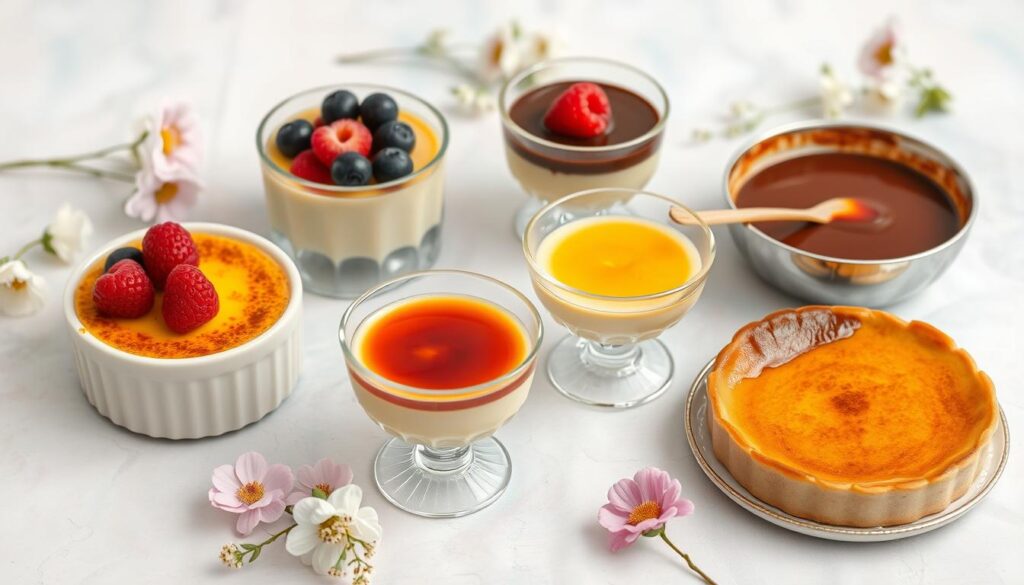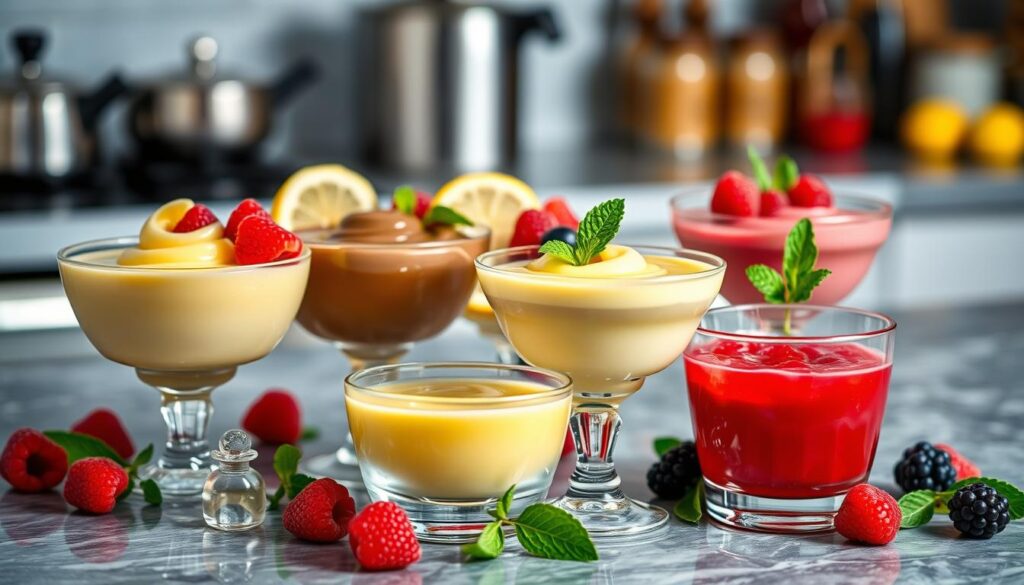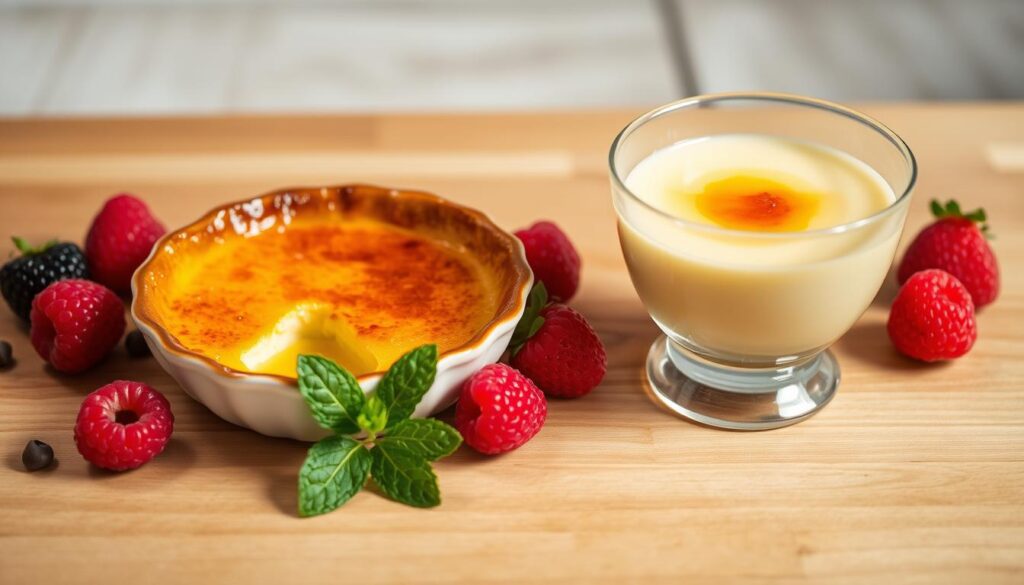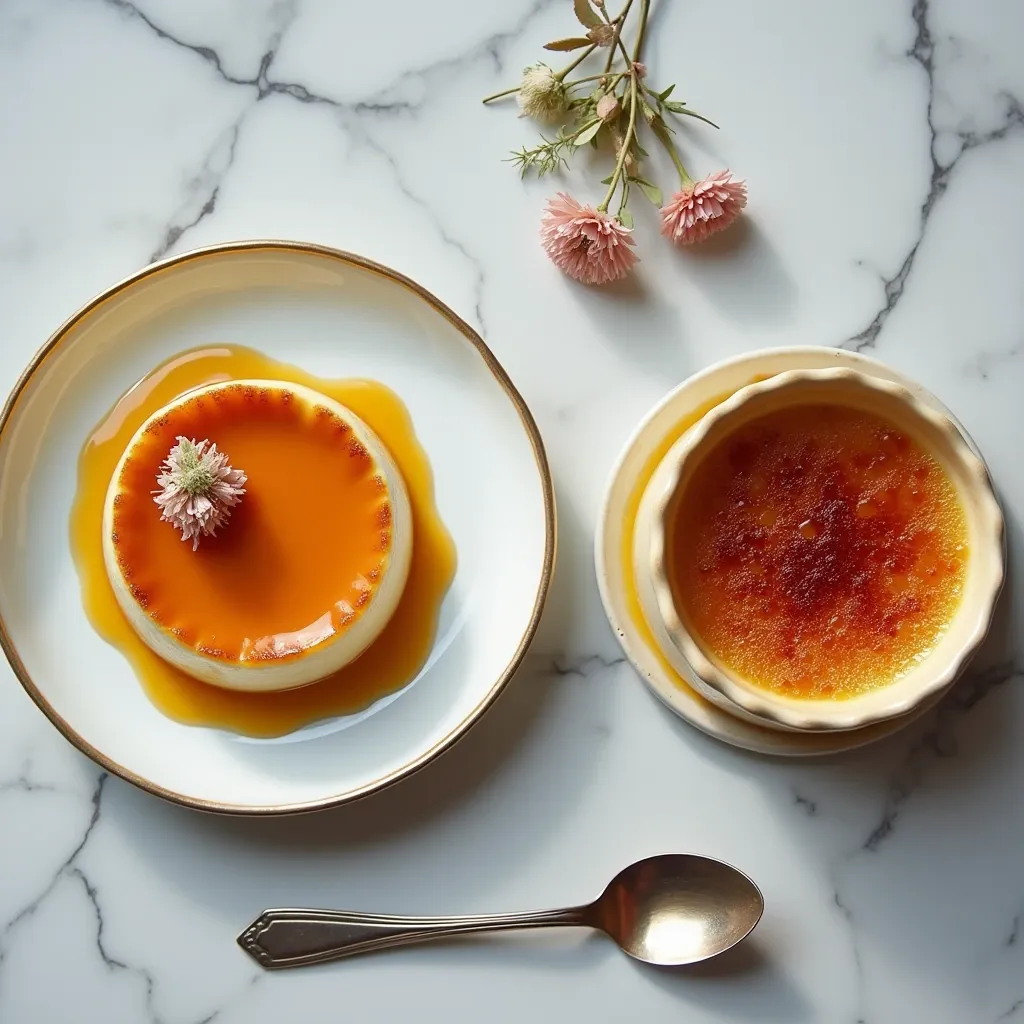Crème brûlée and custard are both loved desserts, but they’re not the same. They share some similarities but have key differences. Knowing these differences helps us enjoy each dessert’s unique qualities.
Crème brûlée is known for its rich, creamy taste and caramelized sugar topping. It’s made with heavy cream, egg yolks, and sugar, giving it a thick texture. On the other hand, custard desserts like crème caramel are lighter. They use whole eggs and more milk, with a caramel topping that’s softer than crème brûlée’s.

Both desserts have a vanilla flavor, but they’re prepared differently. Crème brûlée is baked in a water bath for even cooking. Custard desserts might be cooked on the stovetop or baked without water. The caramel topping on crème brûlée is special, made with a culinary torch for that crunchy surface.
Understanding Custard-Based Desserts
Custard-based desserts are loved by many, with classics like crème brûlée, crème caramel, and flan. They all use eggs, dairy, and sugar to create a smooth, rich taste. Each dessert has its own special flavor and feel.
Types of Classic Custard Desserts
Crème brûlée has a caramelized top, while crème caramel is creamy like flan. These desserts show how versatile custard can be. They can be baked, stirred, or steamed, each way making them unique.
Basic Custard Components
The key ingredients in custard desserts are eggs, milk or cream, sugar, and sometimes vanilla. These simple things mix together to make a smooth, creamy treat. It’s a favorite among dessert lovers for centuries.
Historical Origins of Custard
Custard desserts have a long history, with roots in many cultures. Crème brûlée comes from 17th-century France, while flan is a staple in Hispanic traditions. Custard’s journey shows its lasting popularity and flexibility as a egg-based dessert.

The Essential Differences Between Crème Brûlée and Custard
Crème brûlée and custard may look similar, but they are not the same. They differ in ingredients, how they’re made, and how they look when served.
Crème brûlée has a thick custard base topped with a hard caramelized sugar. On the other hand, crème caramel is lighter. It uses whole eggs, milk, and cream, and has a liquid caramel sauce.

The way the caramel is made is a big difference. Crème brûlée’s sugar topping is torched or broiled, making a crunchy shell. Crème caramel’s caramel is made separately and poured into the ramekin before baking.
The texture differences and caramel variations make these two desserts unique. Knowing these differences helps you pick the perfect custard-based treat for your sweet tooth.
The Rich History of Crème Brûlée
Crème brûlée is a favorite French dessert with a long history. It’s loved for its creamy custard and caramelized sugar on top. This mix of textures is what makes it so special.
Origins in French Cuisine
The first mention of crème brûlée was in 1691. It was in “Le Cuisinier Royal et Bourgeois” by François Massialot. Even though it wasn’t common in the 19th and 20th centuries, it’s now a favorite in fine dining.
Evolution Through Different Cultures
Crème brûlée has changed over time, with different cultures adding their own twist. It became very popular in the U.S. in the 1980s and 1990s. It’s now seen in movies, TV, and books, showing its global appeal.
Key Ingredients in Traditional Crème Brûlée
At the heart of the classic crème brûlée is a rich custard base. It’s made from a mix of dessert ingredients. The recipe includes 2 cups of heavy cream, 6 large egg yolks, and 3/4 cup of granulated sugar.
To add its signature vanilla flavor, a fragrant vanilla bean or 1 teaspoon of vanilla extract is used.
The caramelized top is made with demerara sugar. It’s sprinkled over the chilled custard and then torched or broiled. This creates a crisp, golden crust. The smooth custard and crunchy topping make crème brûlée a delight.
The exact measurements and techniques may vary. But the essential ingredients are always the same. These are heavy cream, egg yolks, vanilla bean, and sugar. With these, a skilled chef can make a stunning and delicious crème brûlée.
The Art of Making Perfect Custard
Making silky smooth custard is an art that needs careful temperature control. It’s important to heat the half-and-half gently until it steams but doesn’t boil. Using a water bath, or *bain-marie*, helps cook it evenly and prevents curdling.
One big mistake in making custard is overcooking, which makes it grainy and curdled. Undercooking, on the other hand, makes it runny and unset. It’s key to temper the eggs right to avoid scrambling. Straining the custard through a fine-mesh sieve gets rid of any cooked egg bits, making it silky smooth.
Temperature Control Techniques
Keeping the right temperature is key when making *baking techniques* like custard. The half-and-half should be heated slowly until it steams, without boiling. Baking the custard in a water bath, or *water bath method*, keeps the temperature steady and prevents overcooking on the edges.
Common Custard Mistakes to Avoid
Overcooking custard makes it curdled and grainy, while undercooking makes it runny and unset. It’s vital to temper the eggs right to avoid scrambling. Straining the custard through a fine-mesh sieve removes cooked egg bits, making it smooth and velvety. This is perfect for dishes like *crab brulee recipe*.
Is crème brûlée the same as custard?
Crème brûlée is a special dessert classification, different from crème caramel. It’s richer and creamier because of more cream and egg yolks. The top is also special, with a hard caramelized layer made by torching it.
Even though crème brûlée and custard desserts share a creamy base, they are not the same. The unique mix of ingredients and caramelization make crème brûlée stand out. It’s a favorite dessert classification for many.
Crème brûlée and custard may seem similar, but they are not the same. The richer texture, caramelized top, and special preparation make crème brûlée unique. It’s a special culinary distinction in the world of sweet treats.
Texture and Consistency Comparisons
In the world of dessert textures, crème brûlée and custard stand out. Crème brûlée has a smooth, rich custard base topped with a hard, crackly caramelized sugar top. This mix of textures is amazing, with the silky custard and the crunchy caramel.
The Signature Caramelized Top
The caramel consistency of the brûlée topping comes from a thin sugar layer. It’s caramelized with a kitchen torch or broiler. This turns the sugar into a shiny, golden crust that breaks with a satisfying crunch, showing the creamy desserts inside.
Custard Base Differences
Crème brûlée and custard both have a custard base, but they’re different. Crème brûlée’s custard is thicker and creamier, thanks to heavy cream. Custard, on the other hand, is lighter and more delicate, made with whole milk or a mix of milk and cream.
Professional Cooking Techniques for Both Desserts
Making the perfect crème brûlée or custard needs skill in cooking. It’s all about culinary skills and dessert preparation. Techniques like temperature control and egg tempering make the dessert smooth and delicious.
For crème brûlée, chefs use a kitchen torch to caramelize the sugar. This creates a crisp layer on top. The custard is cooked in a water bath to keep the temperature steady. Straining the custard makes it silky and smooth.
In crème caramel, caramel is made first and poured into ramekins. Then, the custard is added. This way, the caramel and custard mix perfectly. Like crème brûlée, controlling the temperature and tempering eggs are key.
Whether you’re making a classic crème brûlée or trying a crab brulee recipe, learning these techniques is essential. They help you make these desserts truly special.
Equipment and Tools Required
Making the perfect crème brûlée needs the right kitchen gadgets, baking tools, and dessert equipment. The recipe requires a few key items for success.
Essential Kitchen Tools
A set of ramekins is at the heart of making crème brûlée. They give each serving its own space. You’ll also need a roasting pan for the water bath, a fine-mesh sieve, and a whisk to get the right texture.
Specialized Equipment for Crème Brûlée
A kitchen torch is key for the caramelized top. An 8-cup glass measuring cup or pitcher makes pouring the custard easy. A small saucepan is used for heating the cream and making the caramel topping.
With these baking tools and dessert equipment, you’re ready to make perfect crème brûlée at home.
Serving and Presentation Methods
Serving desserts like crème brûlée and custard requires great attention to detail. Crème brûlée is often served in its ramekin, highlighting the caramelized top. This top contrasts beautifully with the creamy custard below. On the other hand, crème caramel is flipped onto a plate, showing off the caramel sauce that flows down the sides.
Both desserts are often topped with fresh berries or mint leaves for color and freshness. For crème brûlée, it’s key to serve it right after caramelizing the top. This ensures the crisp texture is preserved, enhancing the diner’s experience.
The art of culinary presentation is vital in improving the dining experience. A beautifully plated dessert can turn a simple crème brûlée or custard into a true gastronomic delight. The choice of serving vessel and garnishes all play a part in the dish’s visual appeal and how it’s perceived by the diner.
Storage and Shelf Life Tips
Keeping crème brûlée and custard-based desserts fresh is key. They need special care to stay good and tasty. This ensures they stay fresh and flavorful.
Both can be kept in the fridge for 3-4 days. For crème brûlée, store it without caramelizing the top. Add sugar just before serving for that crisp texture. Custard-based desserts, like crème caramel, can be stored in ramekins. Invert them when ready to serve. Cover them tightly with plastic wrap to keep flavors out.
Freezing is not recommended. It can ruin their texture and consistency. Keeping them at the right temperature and avoiding too much moisture is crucial.
FAQ
Is crème brûlée the same as custard?
Crème brûlée and custard share similarities but are not the same. Crème brûlée is richer, made with heavy cream and egg yolks. It has a caramelized sugar top. Custard, like crème caramel, is lighter, uses whole eggs, and has a liquid caramel sauce.
What are the different types of classic custard desserts?
There are many custard desserts, including crème brûlée, crème caramel, and flan. They all use eggs, milk or cream, sugar, and flavorings like vanilla. Custards have a long history, with many variations around the world.
What are the main differences between crème brûlée and custard?
Crème brûlée has a thick custard base and a caramelized sugar top. Crème caramel is lighter, uses whole eggs, and has a liquid caramel sauce. The main differences are in ingredients, preparation, and presentation.
What is the history of crème brûlée?
Crème brûlée comes from French cuisine, known for its creamy texture and caramelized top. Over time, it has evolved and been adapted by many cultures, leading to different versions.
What are the traditional ingredients in crème brûlée?
Traditional crème brûlée includes heavy cream, egg yolks, vanilla, sugar, and salt. The recipe calls for 4 cups of half-and-half, 6 large egg yolks, 2 large eggs, and ¾ cup of granulated sugar. Additional demerara sugar is needed for the caramelized top.
What are the key techniques for making perfect custard?
Making perfect custard requires precise temperature control, proper egg tempering, and a water bath for even cooking. Avoid overcooking to prevent curdling and undercooking to avoid a runny texture. Strain the custard for a smooth texture.
How are crème brûlée and custard different?
While crème brûlée is a type of custard, it differs from others like crème caramel. Crème brûlée is richer, with more cream and egg yolks. It has a hard caramel top and is prepared with torch caramelization.
What are the key differences in texture and consistency between crème brûlée and custard?
Crème brûlée has a smooth, rich custard base and a hard caramel top. Crème caramel is lighter, with a liquid caramel sauce. Crème brûlée is thicker and creamier, while crème caramel is firmer and can stand when inverted.
What are the professional techniques used for making crème brûlée and custard?
Professionals use precise temperature control, proper egg tempering, and a water bath for even cooking. For crème brûlée, a kitchen torch is used to caramelize the sugar. For crème caramel, caramel is prepared separately and poured into ramekins before adding the custard.
What equipment is needed to make crème brûlée and custard?
You’ll need ramekins, a roasting pan for the water bath, a fine-mesh sieve, and a whisk. For crème brûlée, a kitchen torch is essential for caramelizing the sugar. An 8-cup glass measuring cup or pitcher is useful for pouring custard into ramekins, and a small saucepan is needed for heating the cream mixture and preparing caramel for crème caramel.
How should crème brûlée and custard be served and presented?
Crème brûlée is served in its ramekin, showcasing the caramelized top. Crème caramel is inverted onto a plate, revealing the caramel sauce. Both are garnished with fresh berries or mint leaves. Crème brûlée should be served immediately after caramelizing the top for the best texture.
How should crème brûlée and custard be stored?
Both desserts can be refrigerated for up to 3-4 days. For crème brûlée, store without caramelizing the top and add the sugar layer just before serving. Crème caramel can be stored in its ramekin and inverted when ready to serve. Cover tightly with plastic wrap to prevent absorption of other flavors from the refrigerator. Do not freeze these desserts as it can affect their texture and consistency.

